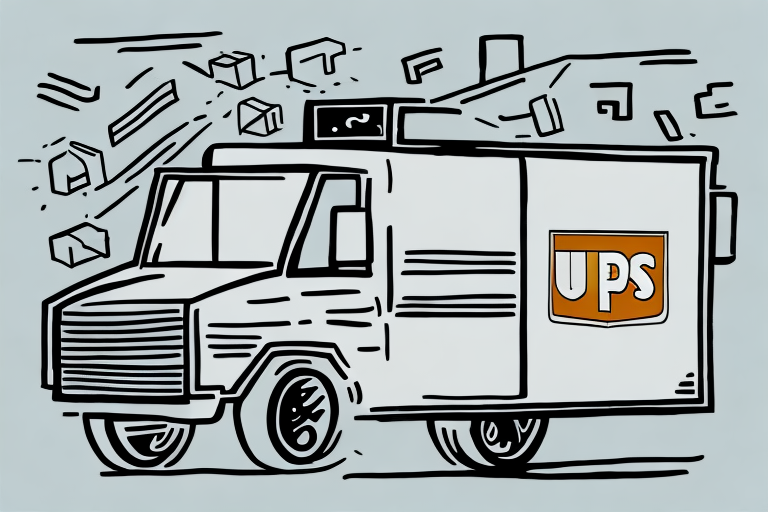Understanding the UPS Chargeback for Next Day Air Early Commercial Delivery
If you run a business that ships time-sensitive packages regularly, it's crucial to understand what UPS Chargeback is and how it may impact your bottom line. In this article, we'll dive into the intricacies of UPS Chargeback for Next Day Air Early Commercial Delivery and help you navigate the complex world of logistics and shipping fees.
What is UPS Chargeback and Why Does It Matter for Businesses?
UPS Chargeback is a fee imposed on shippers by UPS when they fail to meet the delivery commitment for Next Day Air Early Commercial shipments. UPS guarantees that packages shipped via this service will arrive by 8:00 a.m. on the scheduled delivery day. If a package does not arrive on time, UPS may issue a chargeback to the shipper, which can be a significant expense for businesses.
The importance of meeting delivery commitments cannot be overstated for businesses that rely on timely deliveries. Late shipments can cause severe disruptions in operations, customer dissatisfaction, and lost revenue. According to a study by Inbound Logistics, 47% of customers are likely to switch to a competitor if they experience repeated shipping delays.
One way businesses can avoid UPS Chargeback is by using UPS's Delivery Intercept service. This service allows shippers to redirect packages to a new address or hold them for pickup at a UPS location. By intercepting a package before it misses its delivery commitment, businesses can avoid the chargeback fee and ensure timely delivery to their customers.
Another factor to consider is the impact of weather and other unforeseen circumstances on delivery times. While UPS guarantees delivery by 8:00 a.m., they cannot control external factors such as severe weather or traffic accidents. Businesses should communicate with their customers about potential delays and have contingency plans in place to mitigate any disruptions to their operations.
The Importance of Next Day Air Early Commercial Delivery for Time-Sensitive Shipments
Next Day Air Early Commercial Delivery is UPS's premium service for time-sensitive shipments that require delivery by 8:00 a.m. the next business day. This service is ideal for businesses that need to send critical documents or products quickly. Industries that commonly use this service include healthcare, legal, and financial services.
The importance of this service is evident in the need for timely deliveries. For instance, in the healthcare industry, timely delivery of medical supplies can be a matter of life and death. Similarly, missing a court filing deadline can result in severe legal consequences.
The manufacturing industry also benefits greatly from Next Day Air Early Commercial Delivery. Manufacturers often need to receive parts or equipment swiftly to avoid costly delays in their production processes. This service ensures that necessary items are delivered on time, maintaining smooth operations.
Furthermore, Next Day Air Early Commercial Delivery isn't limited to domestic shipments. It offers international delivery options, allowing businesses to send time-sensitive shipments globally. This is particularly important for companies operating on an international scale, ensuring that their products or documents arrive at their destinations promptly.
How to Qualify for UPS Next Day Air Early Commercial Delivery Service
To qualify for UPS Next Day Air Early Commercial Delivery service, your package must be ready for pickup before the scheduled pickup time and meet specific service requirements. Packages must weigh less than 150 lbs and have a maximum length of 108 inches and a maximum package length plus girth of 165 inches.
To ensure that your package qualifies for the service, it's best to consult with your local UPS representative or use the UPS online shipping tool to verify the requirements.
It's important to note that UPS Next Day Air Early Commercial Delivery service is only available in select areas and for certain destinations. Before scheduling a pickup, make sure to check if the service is available in your area and if it can be delivered to your desired destination. Additionally, there may be additional fees associated with this service, so it's best to confirm the cost with your local UPS representative or through the online shipping tool.
What Factors Influence the UPS Chargeback Rate?
The UPS Chargeback rate is influenced by several factors, including the shipper's history of on-time delivery, the weight of the package, and the destination. The farther the destination, the higher the risk of delay, which can result in a higher Chargeback rate. Additionally, shipping volume and peak seasons can affect the Chargeback rate, with higher volumes leading to more Chargebacks.
Another factor that can influence the UPS Chargeback rate is the type of product being shipped. Certain products, such as perishable items or hazardous materials, may require special handling or transportation, increasing the risk of delay or damage and resulting in a higher Chargeback rate.
Furthermore, the level of communication between the shipper and the recipient can impact the Chargeback rate. If the recipient is not aware of the shipment's arrival or is not available to receive it, the package may be delayed or returned, resulting in a Chargeback. Therefore, it is essential to ensure that the recipient is informed and available to receive the package to avoid Chargebacks.
Tips to Reduce Your UPS Chargeback Fees and Save Money
To reduce your UPS Chargeback fees and save money, implement strategies that improve your on-time delivery percentage. These strategies include:
- Plan Ahead: Schedule your shipments in advance and allow enough time for pickup and transit.
- Package Effectively: Use sturdy, crush-resistant packaging that meets UPS requirements and secures the contents of the package.
- Use UPS Technology: Utilize the UPS online shipping tool and other digital solutions to manage your shipments and track their progress in real-time.
- Monitor Performance: Keep track of your delivery metrics and use the data to identify areas for improvement.
Another important strategy to reduce your UPS Chargeback fees is to accurately measure and weigh your packages. Incorrect measurements or weight can result in additional fees and charges. Use a reliable scale and measuring tool to ensure that your packages meet UPS requirements. Additionally, consider using UPS's dimensional weight calculator to determine the most cost-effective shipping option for your packages.
Common Mistakes That Lead to Higher UPS Chargeback Rates
Some common mistakes that can result in higher UPS Chargeback rates include:
- Last-Minute Shipments: Rushed shipments are more likely to experience delays and result in Chargebacks.
- Incorrect Addressing: Incorrect or incomplete addresses can cause delays, leading to Chargebacks.
- Inadequate Packaging: Weak or faulty packaging can cause delays or damage to the package, resulting in Chargebacks.
- Using Subpar Shipping Services: Cutting corners on shipping services can save money in the short term but lead to delays and Chargebacks in the long run.
Another common mistake is failing to properly declare the value of the package. If the value of the package is not declared accurately, it can result in incorrect fees being charged, leading to Chargebacks.
Additionally, not properly tracking packages can result in Chargebacks. If a package is lost or delayed and there is no way to track it, a Chargeback may be issued.
The Impact of UPS Chargeback on Your Business's Bottom Line
UPS Chargebacks can significantly impact your business's bottom line, especially if you ship frequently using Next Day Air Early Commercial Delivery service. The fees for Chargebacks can range from $15 to $225 per package, depending on factors such as destination and package weight.
To mitigate the impact of Chargebacks, it's crucial to manage your shipments effectively and continuously monitor your delivery metrics.
Understanding the reasons why UPS may issue a Chargeback is also important. Common reasons include incorrect package dimensions or weight, incorrect address information, and missing or incorrect documentation. By ensuring that all of your shipment information is accurate and up-to-date, you can reduce the likelihood of receiving a Chargeback and ultimately protect your business's bottom line.
How to Dispute a UPS Chargeback and Increase Your Chances of Success
If you receive a Chargeback from UPS that you believe is incorrect or unwarranted, you can dispute the charge. Disputing a Chargeback can be a time-consuming and complicated process, but there are steps you can take to increase your chances of success, including:
- Provide Evidence of Timely Delivery: If you have proof that the package arrived on time, such as a signed delivery confirmation, submit it along with your dispute.
- Review Your Shipping Documents: Check to ensure that you followed all the requirements for the Next Day Air Early Commercial Delivery service.
- Contact UPS: If you have questions or need assistance with your dispute, contact the UPS customer service team for guidance.
It's important to note that disputing a Chargeback can take several weeks or even months to resolve. During this time, keep detailed records of all communication with UPS and any evidence you submit. Additionally, it's recommended to seek the advice of a legal professional who specializes in Chargeback disputes to ensure that you are taking all the necessary steps to increase your chances of success.
Case Studies: Real-Life Examples of Successful Dispute Resolutions with UPS Chargebacks
Several businesses have successfully disputed Chargebacks from UPS by citing errors in delivery notifications or other issues. For example, a law firm successfully disputed a Chargeback after providing evidence that the package was delivered on time and that the late delivery notification was due to a technology glitch.
These cases highlight the importance of monitoring your delivery metrics and keeping detailed records of all your shipments to support your disputes effectively.
Best Practices for Managing Your UPS Shipments and Avoiding Chargebacks
Effective management of your UPS shipments can help you avoid Chargebacks and ensure timely deliveries. Some best practices to adopt include:
- Use the Right Service: Choose the UPS service that best meets your shipping needs and requirements.
- Communicate with Your Customers: Keep your customers informed of shipping delays or issues that may affect their shipments.
- Monitor Your Shipments: Track your shipments in real-time using UPS technology and proactively address any potential issues.
- Stay Organized: Maintain accurate and up-to-date records of all your shipments, including invoices, bills of lading, and delivery receipts.
The Future of UPS Chargeback: Trends, Innovations, and Predictions
UPS is continually investing in technology and innovations to improve its logistics services and reduce the risk of Chargebacks. For example, the UPS OnCall Air service allows shippers to request pickups outside normal operating hours, providing greater flexibility for time-sensitive shipments. Additionally, UPS My Choice offers customers greater visibility and control over their deliveries.
As the logistics industry continues to evolve, it's essential to stay updated on the latest trends and innovations to ensure your business remains competitive and efficient in its shipping processes. Adopting new technologies and best practices can help mitigate Chargeback risks and enhance overall shipping performance.






















